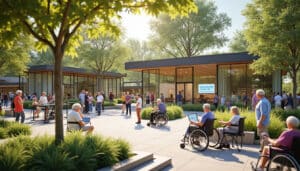Welcome to our platform. Your online experience matters to us. Find out how we protect your data.
We use cookies and data to deliver and maintain our Google services. This allows us to track disruptions and protect against spam, fraud, and abuse. By accepting all options, we develop and improve new services while measuring ad effectiveness. This way, you will benefit from personalized content and ads tailored to your preferences. If you choose to refuse everything, we will not use cookies for these additional purposes. The non-personalized content remains influenced by your current activity and general location. To manage your privacy settings, select “More options” and explore the available tools.

The silver economy is experiencing remarkable expansion, driven by the aging population and increasing longevity. This sector, focused on the needs and expectations of the elderly, opens up new economic and social opportunities. But what is driving this growth and what are its impacts on our society? Let’s explore together the various aspects of this evolving dynamic.
What are the key factors driving the growth of the silver economy?
Several factors contribute to the rise of the silver economy. First, the increase in life expectancy and the decline in birth rates in many countries create a growing proportion of elderly people in the population. This demographic shift modifies economic and social priorities, encouraging businesses to adapt their products and services to meet the specific needs of this segment.
Moreover, technological advancements play a crucial role. Innovations in health, home automation, and communication facilitate seniors’ autonomy and improve their quality of life. For example, specialized startups develop apps for managing chronic diseases or home services, thus addressing the growing needs for care and assistance.
Furthermore, the purchasing power of seniors is increasing. Many have capital and are willing to invest in products and services tailored to their needs, whether in health, leisure, travel, or technology. This influx of financial resources stimulates the creation of new businesses and fosters innovation across various sectors.
How does the silver economy influence the tourism sector?
The cultural tourism sector is particularly impacted by the silver economy. Seniors, having more free time and disposable income, are eager consumers of organized trips and tailored stays. This leads tourism players to offer specific packages that include cultural activities, guided excursions, and comfortable accommodations.
The development of cultural tourism is thus energized, creating local economic synergies and promoting heritage preservation. Tourist destinations invest in suitable infrastructure, such as accessible transport and resting centers, to attract this new clientele. Moreover, travel becomes a vector for socialization and well-being, enhancing the satisfaction and loyalty of senior consumers.
At the same time, digital technologies are transforming the tourist experience. Mobile apps allow for personalized itineraries and facilitate the booking of specific services, while online platforms foster exchanges between travelers and service providers. This digitization enhances the attractiveness of tourist offerings aimed at seniors, making their experiences smoother and more enjoyable.
What technological innovations support the silver economy?
Technological innovation is at the heart of the success of the silver economy. Health technologies, for example, play a vital role by enabling remote medical monitoring and improving diagnostics. Connected devices, such as smartwatches and monitoring equipment, provide greater autonomy and better management of chronic illnesses.
Home automation also represents a significant advancement. Smart homes equipped with automated systems facilitate the daily lives of seniors by ensuring optimal security and simplifying routine tasks. Solutions like voice assistants or care robots allow for intuitive interaction and are adapted to the physical capabilities of users.
In the field of communications, technologies facilitate maintaining social connections. Video conferencing platforms, dedicated social networks, and messaging apps enable seniors to stay connected with their loved ones, thereby reducing the risk of isolation. These innovations enhance mental and emotional well-being, contributing to a better quality of life.
The integration of artificial intelligence (AI) opens up new perspectives. AI enables services to be personalized based on individual needs, anticipating the preferences and requirements of senior users. For example, recommendation systems can suggest activities, content, or care tailored to users, thereby optimizing the user experience.
What challenges must the silver economy overcome?
Despite its strengths, the silver economy faces several challenges. One of the main challenges is the issue of accessibility. It is essential to ensure that products and services designed for seniors are truly accessible in terms of both cost and ease of use. Companies must be mindful to design inclusive offerings that consider varying levels of technological competence and physical limitations.
Another major challenge is awareness and training. Seniors need to be educated on using new technologies to fully benefit from them. Training initiatives and technical support are necessary to ensure successful adoption and avoid digital exclusion.
The protection of personal data is also a significant concern. With the increased use of connected technologies, the security of sensitive information must be strengthened. Companies must implement robust measures to protect the privacy of senior users and establish lasting trust.
Finally, the adaptability of infrastructure poses a crucial issue. Cities and public spaces must be rethought to accommodate an aging population. This includes improving public transport, ensuring building accessibility, and creating dedicated spaces for seniors’ well-being.
What opportunities does the silver economy offer entrepreneurs?
The silver economy opens up a vast field of opportunities for innovative entrepreneurs. The growing need for home health services, tailored technological solutions, or specific leisure creates a burgeoning market. Startups can capitalize on this demand by developing innovative products, such as smart medical devices or tele-assistance platforms.
The quality of services is a determining factor in attracting and retaining senior consumers. Entrepreneurs should focus on creating ergonomic, intuitive, and personalized solutions that precisely meet the expectations of this demanding clientele.
The wellness and leisure sector also represents a promising niche. Tailored travel offers, gentle sports activities, or personal development programs can meet the aspirations of seniors seeking dynamism and socialization. Moreover, the market for luxury products designed for the elderly, such as ergonomic clothing or wellness accessories, is experiencing growing demand.
Intersectoral collaborations offer interesting synergies. For example, partnerships between technology companies and health institutions can lead to innovative solutions for medical monitoring or rehabilitation. These collaborations enhance competitiveness and facilitate the emergence of ambitious projects aligned with the needs of the silver economy.
How do public policies support the silver economy?
Public policies play a decisive role in the development of the silver economy. Governments implement initiatives to encourage innovation and support businesses specialized in services for seniors. Grants, tax credits, and research assistance are often available to stimulate investments in this sector.
Moreover, legislation is evolving to better protect the rights of the elderly and ensure their access to essential services. Regulations regarding the safety of medical devices, the protection of personal data, and the accessibility of infrastructures are strengthened to meet the growing demands of this population.
Training and vocational retraining programs are also essential. They allow for a workforce specialized in the field of services for seniors, ensuring a high quality of offerings. Additionally, awareness campaigns are conducted to promote the importance of the silver economy and encourage the involvement of all economic players.
What future prospects does the silver economy offer?
The silver economy presents promising prospects for the future, both economically and socially. With the ongoing aging of the global population, this sector will continue to grow, providing sustainable and diverse opportunities. Technological innovations, the creation of new jobs, and the emergence of innovative business models are all factors that will contribute to the sustainability of this economy.
Moreover, the positive impact on seniors’ quality of life and social cohesion is undeniable. By effectively addressing the needs of the elderly, the silver economy promotes a more inclusive and supportive society. Initiatives aimed at improving the health, well-being, and autonomy of seniors contribute to better intergenerational harmony and a more balanced economy.
Finally, the growth of the silver economy stimulates research and development in various fields, ranging from health to technology to tourism and well-being. This dynamic encourages continuous innovation, ensuring that the services and products offered remain relevant and adapted to the evolving needs of seniors.
How to choose the right strategies to integrate the silver economy?
Effectively integrating the silver economy requires strategic thinking and a deep understanding of seniors’ needs. Companies must adopt a user-centered approach, involving older individuals in the design and development process of products and services. This ensures that the proposed solutions are truly suitable and meet their expectations.
It is also crucial to foster innovation and collaboration. Partnerships with specialized actors, such as health institutions, technology companies, and senior organizations, can enrich offerings and broaden market opportunities. Investment in research and development keeps businesses at the forefront of technological advancements and enables them to propose innovative solutions.
Effective communication is essential to reach and retain the senior clientele. Marketing strategies must be adapted, prioritizing accessible communication channels and highlighting the concrete benefits of products and services. Transparency, simplicity, and clarity in messaging enhance trust and facilitate the adoption of the proposed solutions.
Finally, businesses must be flexible and ready to adapt to market changes. The silver economy is in constant flux, and the needs of seniors can evolve rapidly. Continuous monitoring and the ability to adjust ensure competitiveness and effective response to new expectations.
What social impacts does the silver economy generate?
The silver economy has significant social repercussions. It contributes to a better integration of seniors into society by promoting their active participation and engagement. Initiatives focused on well-being and health help reduce social isolation and improve the quality of life for the elderly.
Moreover, the growth of this sector encourages broader reflection on aging policies and intergenerational solidarity. It prompts a reconsideration of health systems, urban infrastructures, and work models to better address the challenges posed by an aging population.
The silver economy also fosters job creation in various sectors, thereby strengthening the local and national economy. Professions in health care, support, software development, and specialized tourism are among the fields benefiting from this dynamic, offering career opportunities for both young and older individuals.
Finally, by valuing the skills and experience of seniors, the silver economy contributes to a more respectful and inclusive society. It recognizes the added value of older individuals and encourages their active participation in various aspects of economic and social life.







